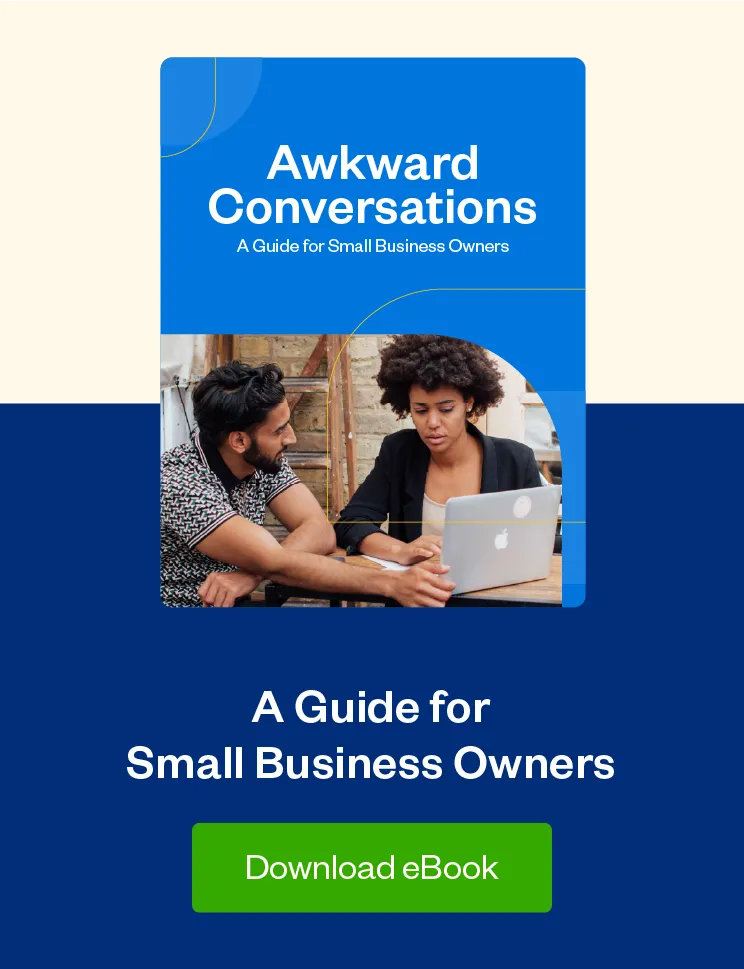Everything you need to know about creating strong client relationships—and how to make those relationships last.

It’s a well-known fact that long-term clients spend more over time, which can have a big impact on your bottom line. According to global management consulting firm Bain & Company, a 5% increase in customer retention can produce more than a 25% increase in profits. So if you want to build a small business that stands the test of time, you need to focus on building relationships with clients—and making those relationships long-lasting.
Like any relationship, if you want your relationships with customers to thrive, you need to put in the time, work and effort. But what does that actually look like?
Here are our top tips for creating lasting, positive and mutually beneficial relationships with your clients.
Table of Contents
1. Do the Work Up-front to Ensure Relationship Success
Building a lasting relationship with clients starts at the very beginning. If you want your client relationships to last, there are steps you need to take from the get-go to set the relationship up for success.
Some of the initial steps you’ll want to take include:
Get to Know Them
Every client has different needs, goals and preferences. So it’s important to take the time to get to know them before you start working on your first project. Try to find out:
- Why are they looking to hire you?
- What are they hoping to get out of the relationship?
- What are their short- and long-term goals?
- What’s their preferred work style?
The more you know about each customer, the more you can cater your work style and services to them specifically—and the better the relationship will be as a result.
Establish Preferred Communication Channels
Again, every client has different preferences, including how they like to communicate. Some will prefer regular phone calls to get an update on the status of your project—while others would be irritated if you called them and interrupted their workday.
That’s why it’s so important to get on the same page as your clients in terms of their preferred communication channels. For example:
- Do they want you to call them with project updates or do they prefer email?
- What’s the fastest way to reach them if you have a question or urgent matter that needs their attention?
- Do they prefer you to submit work via email, Google Drive or through a project management platform (like Trello or Asana)?
Taking the time to understand how your customer likes to communicate will start the relationship off on the right foot—which, in turn, can help you lay the foundation for a strong relationship.
Set Proper Expectations
In addition to laying the foundation for communication, it’s also important to set proper expectations with clients prior to working on your first projects.
Some expectations you’ll want to agree on before you start working together include:
- Rates and pricing: It’s important to get on the same page about rates and pricing before getting started on your first project. That way, there are no surprises when you send your first invoice.
- Project timelines: It’s also important to discuss timelines for different types of work and expectations on timelines from both of your perspectives. So, for example, do you ask for at least two weeks’ lead time for any new projects? Do they have a project they need wrapped up in the next 30 days? What about rush jobs they need turned around quickly? Get on the same page about how long different types of projects will take to complete.
- Boundaries: If you have any boundaries you want to set, the start of the relationship is the time to (kindly) set them. For example, do you not answer emails after 9 p.m. or on weekends? Do you require payment within 30 days of sending an invoice? Do you ask for 24 hours to respond to non-urgent emails? Whatever boundaries you have around working together, let your client know from the get-go—and give them the opportunity to do the same.
2. Foster Open Communication
The most successful client relationships are the ones that foster open communication. Your clients need to be able to get in touch with you, feel comfortable asking you questions and, in general, feel like you’re easy to reach and communicate with.
Do whatever it takes to foster open communication with your client. While this will look different for every customer—and every relationship—it may include:
- Regular conference calls
- Daily email updates
- Brainstorming sessions with the client and their team
- In-person meetings
The more you open the lines of communication between yourself and your client, the more comfortable they’ll feel with you—and the more likely it is that the relationship will go from a one-time client to a long-lasting one.
3. Go Above and Beyond
The difference between having a good versus a great relationship with your client will, in large part, depend on how you show up for them.
Going above and beyond to make sure your client has a positive experience—and that your work exceeds their expectations—will solidify the relationship. You’ll also become the go-to resource for your clients.
There are a ton of ways you can go above and beyond, exceed your client’s expectations and strengthen the relationship, including:
- Train your client on how to best leverage your work. If your client hired you to create something for them, it’s one thing to deliver that asset. But it’s another to train them on how to use it. For example, let’s say you designed a website for your client. Instead of just sending over the design files, offer to train them on how to navigate the backend of the website or host a Q and A to answer any questions their team has about how to use the site.
- Share your expertise outside of the scope of work. Your client hired you for a specific service or product. But chances are, that’s not all you have up your sleeve. As you get to know your client, look for ways to share your knowledge and apply your expertise to a wider range of problems. By going above and beyond your original scope of work, not only will you impress your client, but you may also open the door for new and different opportunities to work together.
- Finish a project ahead of schedule. If you have the capacity, wrapping up a project early is a great way to show clients you’re committed to your work—and that you’ll go the extra mile to get things done in a timely manner.
Going above and beyond for your clients will help instil a sense of trust and respect. Your clients will feel as though you’re a partner they can rely on—which can go a long way in creating relationships that last.
4. Treat Your Client Like a Person
Building client relationships is just like building any other relationships; they’re built on mutual respect, kindness and understanding. Or, in other words, your client is a person—and if you want to have a strong relationship with them, you need to treat them like one.
A little kindness, warmth and old-fashioned common courtesy can go a long way when creating relationships with clients.
For example:
- If you know your client’s company is going through a major rebrand, check-in and ask how it’s going—even if you’re not working on any current projects.
- Shoot your client an email and see how they’re feeling if you know they were out sick for a few weeks.
- Don’t just send the bill and call it a day if you’re wrapping up a project. Instead, include a polite note thanking them for processing your invoice and asking them to reach out with any questions or concerns.
Now, treating your client with warmth and courtesy is important. But it’s also important not to overstep your professional boundaries. You want to be friendly, but remember that you’re dealing with a client—not a buddy. Avoid anything too personal (and definitely avoid anything that could be construed as offensive or inappropriate).
5. Ask for Feedback—and Then Implement It
You want to do the best job possible for all your clients—and in order to do that, you need to ask for feedback. But feedback isn’t going to strengthen your relationship unless you actually take that feedback and use it to improve.
When a client offers feedback, take the time to really listen. Ask questions. Repeat what you understand back to them to ensure that you’re on the same page. Then, take that feedback, apply it to what you’re working on together and follow up to confirm that they’re happy with the changes.
By acting on your clients’ feedback, you’re showing them that you hear them, you respect them and you’re willing to do whatever it takes to ensure they’re happy with your work—all crucial elements in building a long-lasting client relationship.
6. Make Their Life Easier
People value ease and convenience. If you want to foster positive and strong relationships with your clients, make sure the process of working with you is as easy as possible.
For example:
- If you need to request feedback on a project, use collaboration tools (like G-Suite) so you can collaborate with your client and incorporate their notes and edits in real-time
- If you need to host an on-site training with your client’s team, offer to get to their office early and manage the setup process
- Instead of making your clients pay out your invoices using checks or direct deposits (which can be time-consuming), use the FreshBooks online payment feature to make the process easier and faster on their end
The point is, the easier and more convenient the process of working with you is for your client, the more they’re going to want to work with you.
7. Own up to Your Mistakes
Trust is an essential part of any good relationship—including the relationships with your clients. And building that trust starts with accepting responsibility when things don’t go as planned.
Everyone makes mistakes. But if you try to cover them up, your clients aren’t going to trust you—and the relationship will suffer.
Simply, own up to your mistakes.
For example, did your client call out a typo on a social media post you sent over? Acknowledge the error, apologize and let them know it won’t happen again. Did one of your team members miss a deadline? Again, acknowledge the mistake and apologize. Then assure them that you’ll be talking to your team member to ensure work is submitted on time moving forward.
You’re human. You’re going to make mistakes. It’s not the end of the world if you own up to them instead of trying to hide them or getting defensive. This shows your clients you’re open, accountable and trustworthy. And it will help to build the foundation for a long-lasting client relationship.
Use These Tips for Building Relationships With Clients That Last
Finding new clients is an important part of running a small business. But if you want your small business to thrive in the long run, you also need to focus on managing relationships with existing clients. Now that you know how to build client relationships that last, you can keep your clients coming back for years to come.
This post was updated in June, 2020.

Written by Deanna deBara, Freelance Contributor
Posted on August 31, 2020

 Finding Clients in Today’s Economy
Finding Clients in Today’s Economy Honest and Direct: How to Say No Politely to a Client
Honest and Direct: How to Say No Politely to a Client Everything You Need to Know About Managing Bad Clients
Everything You Need to Know About Managing Bad Clients





